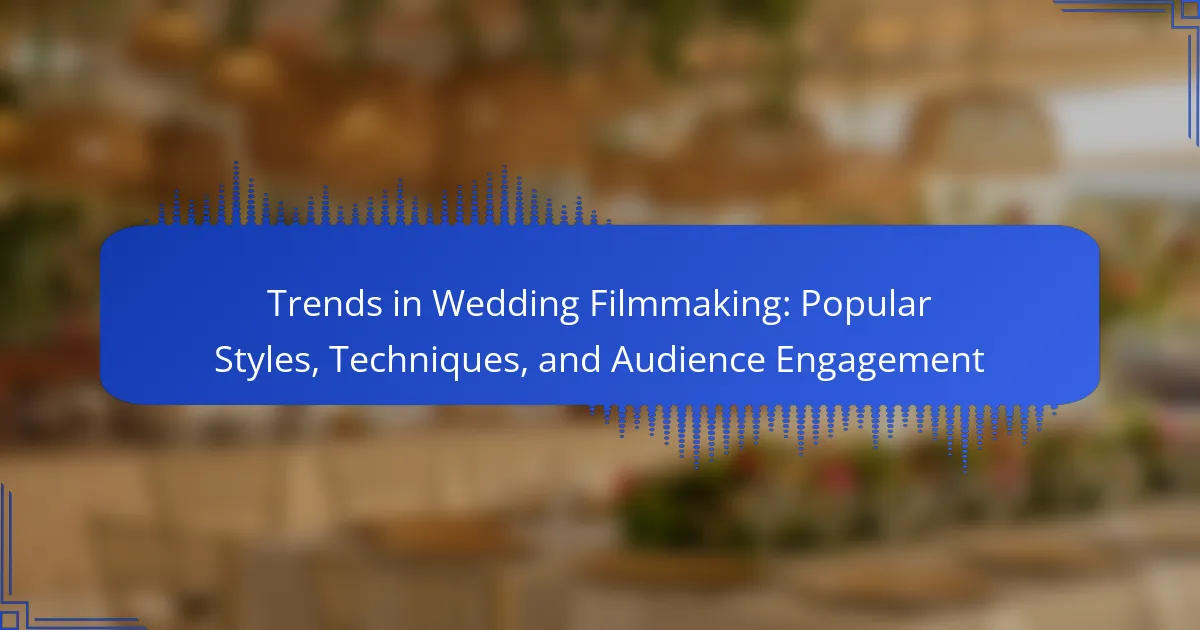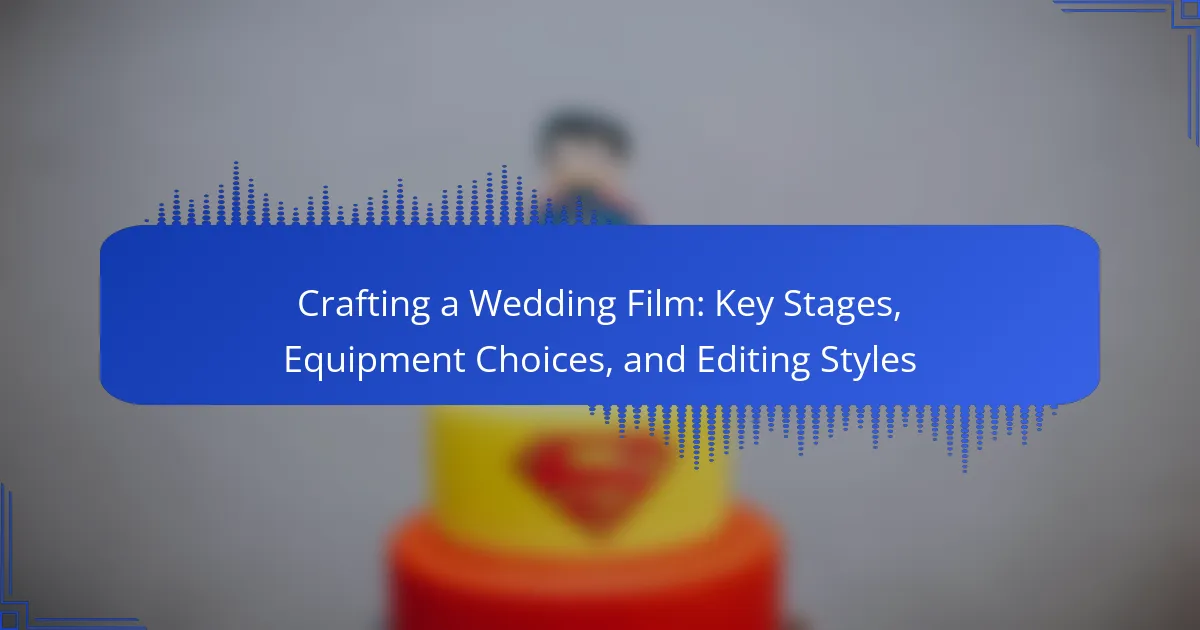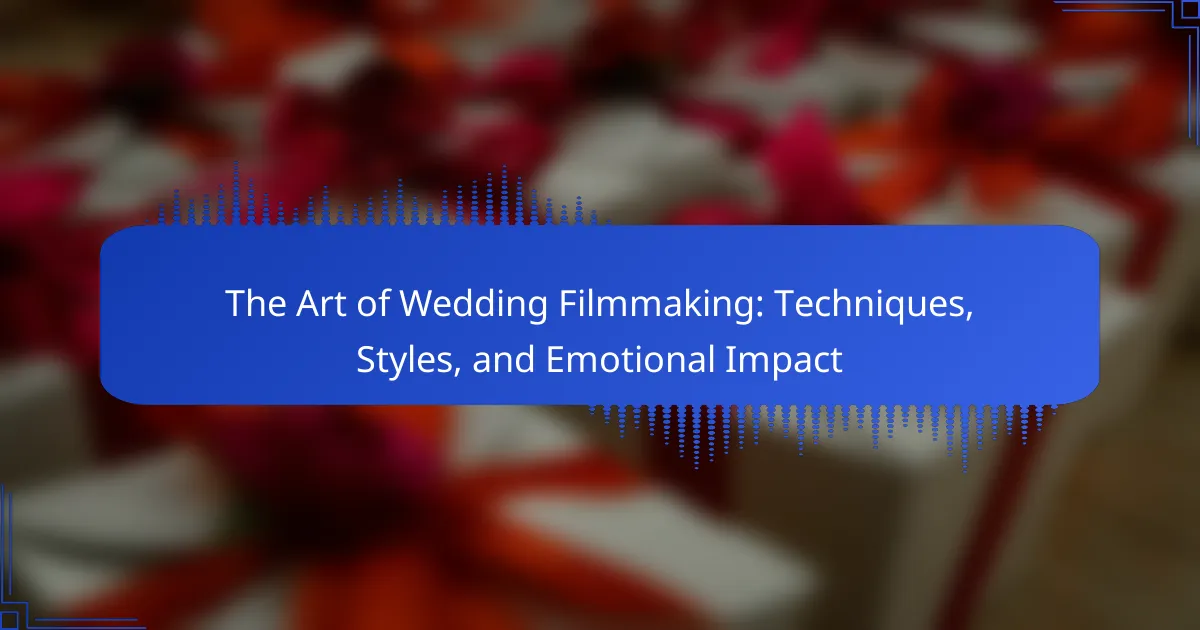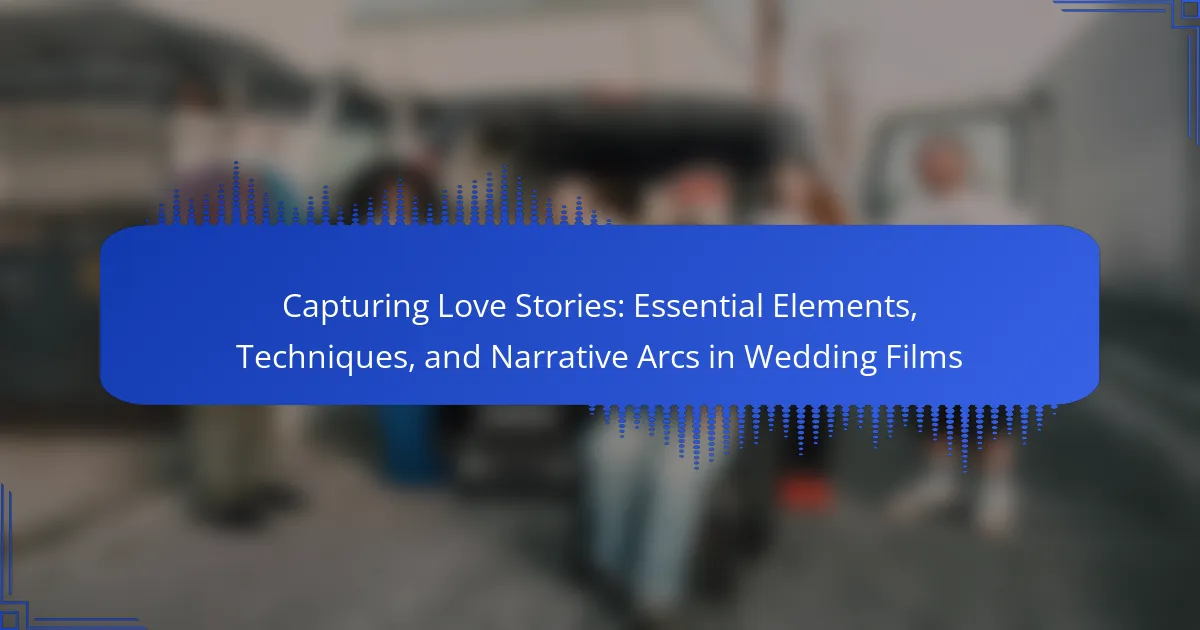Wedding filmmaking is evolving with current trends emphasizing cinematic storytelling, drone footage, and live streaming. Filmmakers are increasingly focused on capturing emotional narratives and genuine moments, utilizing unique aerial perspectives and allowing remote guests to participate in real-time. As couples lean towards shorter highlight reels and social media-friendly clips, filmmakers adapt their techniques based on audience feedback and data analytics. Key best practices include effective planning, clear communication with couples, and maintaining a discreet presence during ceremonies to enhance the authenticity of captured moments. This article explores these popular styles, techniques, and the importance of audience engagement in contemporary wedding filmmaking.

What are the current trends in wedding filmmaking?
Current trends in wedding filmmaking include the use of cinematic storytelling techniques, drone footage, and live streaming. Cinematic storytelling emphasizes emotional narratives, capturing genuine moments throughout the day. Drone footage provides unique aerial perspectives, enhancing the visual appeal of wedding videos. Live streaming allows remote guests to participate in real-time, increasing accessibility. Additionally, couples prefer shorter highlight reels that showcase key moments rather than lengthy films. The integration of social media elements, such as Instagram-friendly clips, is also gaining popularity. These trends reflect evolving preferences for personalization and engagement in wedding filmmaking.
How have wedding filmmaking styles evolved over the years?
Wedding filmmaking styles have evolved significantly over the years. Initially, wedding films were straightforward recordings of the ceremony. These early films often lacked creativity and were primarily documentary in nature. With advancements in technology, filmmakers began incorporating artistic elements. The introduction of more sophisticated cameras allowed for better quality and varied angles.
In the 1990s, cinematic styles emerged, emphasizing storytelling and emotional engagement. Filmmakers started using techniques like slow motion, creative transitions, and music synchronization. This shift aligned with the rise of independent cinema, influencing wedding films to adopt a more narrative-driven approach.
The digital revolution further transformed wedding filmmaking. The accessibility of editing software enabled filmmakers to produce high-quality films with unique styles. Today, popular trends include drone footage, highlight reels, and personalized storytelling. These modern styles focus on capturing the couple’s personality and the day’s emotions.
As a result, wedding filmmaking has transitioned from basic recordings to immersive cinematic experiences. This evolution reflects broader trends in media consumption and audience expectations.
What are the most popular styles in wedding filmmaking today?
The most popular styles in wedding filmmaking today include cinematic, documentary, and storytelling. Cinematic style emphasizes high production value and artistic visuals. It often features dramatic angles, creative editing, and a focus on the couple’s emotions. Documentary style captures events as they unfold, prioritizing authenticity and real moments. This approach often results in a natural and unscripted feel. Storytelling style blends elements of both cinematic and documentary, creating a narrative arc that highlights key moments and emotions. Each style appeals to different preferences, reflecting the diverse tastes of modern couples.
How do cultural influences shape wedding filmmaking styles?
Cultural influences significantly shape wedding filmmaking styles by dictating the themes, aesthetics, and rituals captured. Different cultures emphasize unique traditions and ceremonies, which filmmakers reflect in their work. For example, Indian weddings feature vibrant colors and elaborate rituals, leading to dynamic filming techniques. In contrast, Western weddings often focus on romantic narratives and simpler visuals. Filmmakers adapt their storytelling methods to align with cultural values, such as familial importance or religious significance. This adaptation enhances the emotional resonance of the films. Furthermore, cultural music and dance styles influence the editing and pacing of wedding films. Specific cultural elements, like traditional attire and ceremonial practices, are highlighted to honor the couple’s heritage. This tailored approach ensures that the final product resonates with the couple and their families.
What techniques are filmmakers using to enhance wedding videos?
Filmmakers enhance wedding videos using techniques like cinematic storytelling, drone footage, and color grading. Cinematic storytelling involves creating a narrative that captures emotions and key moments. This technique often includes interviews with the couple and their families. Drone footage provides breathtaking aerial views of the venue and guests, adding a unique perspective. Color grading enhances the visual appeal by adjusting tones and contrasts for a polished look. Slow-motion shots emphasize significant moments, like the first kiss or dance. Time-lapse sequences can showcase the event’s progression, from setup to celebration. Additionally, filmmakers often incorporate music that resonates with the couple’s story, further enhancing emotional engagement.
What role does technology play in modern wedding filmmaking?
Technology plays a crucial role in modern wedding filmmaking. It enhances the quality of video production through advanced cameras and editing software. High-definition cameras capture detailed visuals, while drones provide unique aerial shots. Editing software allows for seamless transitions and special effects. Additionally, technology enables live streaming of weddings, making events accessible to remote guests. The use of social media platforms allows filmmakers to share highlights quickly. Overall, technology transforms wedding filmmaking into a more dynamic and engaging experience.
How can filmmakers use storytelling techniques in wedding films?
Filmmakers can use storytelling techniques in wedding films by structuring the narrative to highlight key moments. They can incorporate elements such as character development, conflict, and resolution. For instance, focusing on the couple’s journey can create emotional depth. Filmmakers can also utilize voiceovers to share personal anecdotes or vows. This technique adds intimacy and context to the visuals. Additionally, employing cinematic techniques like montage can effectively showcase the day’s progression. Filmmakers can enhance storytelling through music selection that resonates with the couple’s story. This approach creates an emotional connection for the audience. By weaving these elements together, filmmakers can craft compelling wedding films that engage viewers.
What are the key elements of audience engagement in wedding filmmaking?
The key elements of audience engagement in wedding filmmaking include storytelling, visual aesthetics, and emotional connection. Storytelling captures the couple’s journey and significant moments. This narrative approach keeps viewers invested. Visual aesthetics enhance the viewing experience through composition and color grading. High-quality visuals attract attention and maintain interest. Emotional connection resonates with the audience, evoking feelings of joy and nostalgia. Engaging content often features candid moments and genuine interactions. According to a study by WeddingWire, 80% of couples prioritize emotional storytelling in their wedding videos. This highlights the importance of these elements in creating impactful films.
How do filmmakers connect emotionally with their audience?
Filmmakers connect emotionally with their audience by using storytelling techniques that resonate with viewers. They create relatable characters that evoke empathy and connection. Emotional music enhances the mood and deepens the viewer’s experience. Cinematic techniques, such as close-ups, highlight emotions effectively. Visual symbolism can convey deeper meanings and feelings. Filmmakers often draw on universal themes like love, loss, and triumph to engage audiences. Research shows that emotional storytelling can significantly increase audience connection and investment in the narrative. According to a study by the University of Southern California, emotional engagement leads to higher retention and enjoyment of films.
What strategies can be used to promote wedding films effectively?
Utilizing social media platforms is a key strategy to promote wedding films effectively. Platforms like Instagram and Facebook allow filmmakers to showcase their work visually. Engaging storytelling in posts can attract potential clients. Collaborating with wedding vendors enhances exposure to their audiences. Hosting giveaways or contests can generate buzz and interest. Creating a dedicated website with a portfolio improves visibility. Utilizing SEO techniques can drive organic traffic to the site. Email marketing campaigns can keep previous clients informed about new offerings.

How do filmmakers adapt to changing audience preferences?
Filmmakers adapt to changing audience preferences by analyzing viewer feedback and trends. They utilize data analytics to understand what resonates with audiences. Social media platforms provide real-time insights into audience reactions. Filmmakers often adjust their storytelling techniques based on these insights. For instance, they may incorporate more diverse narratives to reflect societal changes. Additionally, they experiment with different visual styles and formats. This includes shorter content to cater to diminishing attention spans. By staying attuned to audience demands, filmmakers can enhance engagement and satisfaction.
What feedback do audiences provide on wedding films?
Audiences provide varied feedback on wedding films. Common comments include appreciation for emotional storytelling. Viewers often highlight the importance of capturing candid moments. Many appreciate high-quality cinematography and editing techniques. Audiences also value personalization in films that reflect the couple’s story. Positive feedback frequently mentions the soundtrack’s role in enhancing the viewing experience. Some viewers express a desire for shorter films to maintain engagement. Overall, feedback indicates that audiences seek authenticity and creativity in wedding films.
How can filmmakers incorporate audience feedback into their work?
Filmmakers can incorporate audience feedback into their work by actively soliciting opinions during the production process. They can conduct surveys or focus groups to gather insights on specific elements like storylines or editing styles. Social media platforms allow filmmakers to engage directly with audiences, asking for their thoughts on trailers or promotional material. Incorporating feedback can lead to adjustments in pacing, music selection, and even narrative direction. Audience screenings provide an opportunity to test content before final release, allowing filmmakers to gauge reactions. Utilizing analytics from digital platforms can reveal viewer preferences and engagement metrics. This data-driven approach helps in refining future projects and improving overall storytelling. By valuing audience input, filmmakers create a more engaging and relatable final product.
What are the emerging preferences of couples regarding wedding films?
Couples are increasingly favoring personalized and cinematic wedding films. They prefer storytelling that captures their unique love journey. Many couples are opting for shorter highlight reels over lengthy full-length films. This trend aligns with the growing consumption of bite-sized video content. Drone footage is becoming popular for capturing breathtaking aerial views of venues. Couples also appreciate films that incorporate interviews with family and friends. Authenticity is key; couples want raw, emotional moments included. The use of social media-friendly formats is also on the rise, catering to sharing on platforms like Instagram.
How do social media and online platforms influence wedding filmmaking?
Social media and online platforms significantly influence wedding filmmaking by shaping trends and audience expectations. They provide a space for filmmakers to showcase their work and connect with potential clients. Platforms like Instagram and TikTok highlight popular styles, making them more accessible. This visibility drives filmmakers to adopt trending techniques to attract viewers. Additionally, user-generated content and hashtags create a community around wedding filmmaking. Filmmakers often draw inspiration from viral videos and popular aesthetics shared online. The demand for unique and personalized content has increased due to social media’s influence. Consequently, filmmakers are more likely to experiment with innovative storytelling methods to stand out.
What platforms are most effective for sharing wedding films?
YouTube is the most effective platform for sharing wedding films. It has over 2 billion users, making it a vast audience for filmmakers. Vimeo is also popular due to its high-quality video playback and creative community. Facebook allows easy sharing among friends and family, enhancing visibility. Instagram is effective for short clips and teasers, attracting younger audiences. TikTok has gained traction for its viral potential, especially with creative snippets. These platforms provide unique engagement opportunities for filmmakers and viewers alike.
How can filmmakers leverage social media trends for audience engagement?
Filmmakers can leverage social media trends to enhance audience engagement by aligning their content with popular platforms and current user interests. They can utilize trending hashtags to increase visibility. Engaging with viral challenges can attract attention to their work. Collaborating with influencers can extend their reach significantly. Sharing behind-the-scenes content creates a personal connection with the audience. Utilizing short-form video formats, like those on TikTok or Instagram Reels, caters to current viewing preferences. Regularly interacting with followers through comments and live sessions fosters community. According to a 2021 survey by Statista, 54% of social media users engage with brands that share relatable content.

What best practices should filmmakers follow in wedding filmmaking?
Filmmakers should prioritize planning and communication in wedding filmmaking. Establishing a clear timeline with the couple ensures all important moments are captured. Conducting a pre-wedding consultation helps filmmakers understand the couple’s vision. Using high-quality equipment is essential for capturing high-definition footage. Filmmakers should also scout the venue beforehand to identify optimal shooting locations.
Maintaining a discreet presence during the ceremony is crucial for authentic moments. Utilizing multiple cameras can provide different angles and perspectives. Editing should focus on storytelling, highlighting emotional moments and key events. Incorporating music that resonates with the couple enhances the overall experience.
Adhering to these best practices can significantly improve the quality and emotional impact of wedding films.
What are the essential steps in the wedding filmmaking process?
The essential steps in the wedding filmmaking process include pre-production, production, and post-production. Pre-production involves planning and consultation with the couple. This step ensures understanding their vision and preferences. Production occurs on the wedding day, capturing key moments and emotions. Filmmakers use various equipment to document the event. Post-production consists of editing the footage into a cohesive film. This stage includes color grading and sound design. Each step is crucial for creating a memorable wedding film. The process typically results in a high-quality product that reflects the couple’s story.
How can filmmakers ensure they capture key moments effectively?
Filmmakers can ensure they capture key moments effectively by planning and being prepared. They should create a shot list that outlines important events and angles. This helps in avoiding missed opportunities during the event. Filmmakers should also use multiple cameras to cover different perspectives simultaneously. This technique provides options during the editing process. Additionally, they should communicate with the couple and key participants to understand expectations. This can lead to capturing emotional and significant moments. Practicing good timing and anticipating reactions is crucial. Filmmakers should also be aware of lighting conditions to enhance visual quality. These methods increase the likelihood of capturing memorable moments.
What tips can help improve the quality of wedding films?
Use high-quality equipment for filming. This ensures better resolution and sound quality. Invest in good lenses to capture sharp images. Utilize stabilizers or gimbals for smooth motion shots. Plan shots in advance to avoid missing key moments. Capture candid moments alongside posed ones for authenticity. Edit with attention to storytelling, creating a narrative flow. Incorporate music that resonates emotionally with the couple. These practices enhance overall production value and viewer engagement.
How can filmmakers build a successful wedding filmmaking business?
Filmmakers can build a successful wedding filmmaking business by focusing on quality, marketing, and client relationships. High-quality video production is essential. This includes investing in professional equipment and editing software. Filmmakers should showcase their work through a well-designed website and social media platforms. Engaging with potential clients through these channels increases visibility. Networking with wedding planners and vendors can lead to referrals. Providing excellent customer service enhances client satisfaction. Positive reviews and testimonials can significantly impact future business opportunities. According to a survey by WeddingWire, 75% of couples consider video an important part of their wedding. This statistic highlights the growing demand for wedding filmmakers.
What marketing strategies are effective for wedding filmmakers?
Effective marketing strategies for wedding filmmakers include leveraging social media platforms, optimizing website content, and building partnerships with vendors. Social media allows filmmakers to showcase their work visually, attracting potential clients. Platforms like Instagram and Facebook are particularly useful for sharing highlights and behind-the-scenes content. Optimizing website content with SEO practices helps filmmakers appear in search results, increasing visibility. Additionally, collaborating with wedding planners, venues, and photographers can lead to referrals. Networking at bridal shows and events further enhances exposure. Statistics show that 80% of couples use social media for wedding planning, highlighting its importance in marketing.
How can networking with other vendors enhance a filmmaker’s reach?
Networking with other vendors can significantly enhance a filmmaker’s reach. Collaborating with vendors like photographers, florists, and event planners increases visibility. Each vendor has their own client base, which filmmakers can tap into. This collaboration leads to referrals and recommendations, expanding the filmmaker’s audience. Additionally, joint marketing efforts can create more impactful promotional campaigns. For example, co-hosting events or workshops can attract a larger crowd. According to a study by WeddingWire, 70% of couples trust vendor recommendations when selecting a filmmaker. Thus, building relationships with vendors is a strategic move for filmmakers aiming to grow their business.
The main entity of this article is wedding filmmaking, which encompasses current trends, styles, techniques, and audience engagement strategies. Key trends include cinematic storytelling, drone footage, and live streaming, reflecting a shift towards personalization and accessibility. The article explores the evolution of wedding filmmaking styles, highlighting the influence of technology and cultural factors. It also discusses effective audience engagement methods, feedback incorporation, and marketing strategies for filmmakers to enhance their business and connect with couples.



